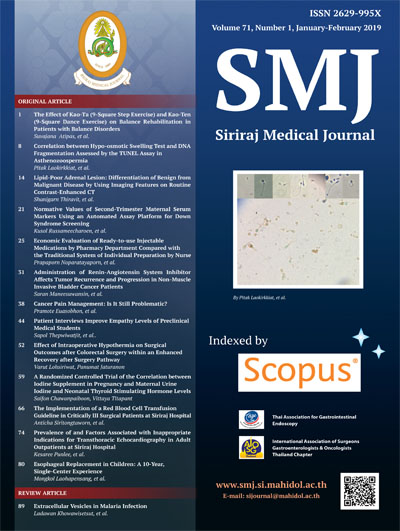Lipid-Poor Adrenal Lesion: Differentiation of Benign from Malignant Disease by Using Imaging Features on Routine Contrast-Enhanced CT
DOI:
https://doi.org/10.33192/Smj.2019.03Keywords:
Adrenal adenoma; adrenal gland; CTAbstract
Objective: To assess the effectiveness of CT imaging features of lipid-poor adrenal lesions on routine contrastenhanced
CTs in differentiating benign from malignant masses.
Methods: A retrospective study was performed on 84 lipid-poor adrenal lesions (HU >10 on unenhanced CT scans),
which were sized 1-4 cm, had a proven final diagnosis, and were detected during routine contrast-enhanced MDCT
studies. Of those, 58 were found in patients with an underlying extra-adrenal malignancy. Two authors determined
the morphological features according to their shape, margin, density on unenhanced images, and enhancement
pattern. The sensitivity, specificity, and positive and negative predictive values were also calculated for each feature
which suggested benignancy, plus a combination of those features.
Results: There were 46 (55%) benign and 38 (45%) malignant adrenal masses. The low-density feature (10-20
HU on unenhanced CT images) indicated as benign with a high specificity of 92%, even in patients with known
malignancy. The other features (round/oval shape, smooth margin, and homogenous enhancement) showed a high
sensitivity (75%-85%) but a low specificity (39%-56%) in predicting benignity. The combined features for presumed
benignancy could predict a benign mass with the highest specificity of 95%.
Conclusion: The small, lipid-poor, adrenal masses detected by routine contrast-enhanced CTs are likely to be benign
when their internal density on unenhanced images is not higher than 20 HU and/or, especially, when a combination
of all morphological features for presumed benignancy presents.
Downloads
Published
How to Cite
Issue
Section
License
Authors who publish with this journal agree to the following conditions:
Copyright Transfer
In submitting a manuscript, the authors acknowledge that the work will become the copyrighted property of Siriraj Medical Journal upon publication.
License
Articles are licensed under a Creative Commons Attribution-NonCommercial-NoDerivatives 4.0 International License (CC BY-NC-ND 4.0). This license allows for the sharing of the work for non-commercial purposes with proper attribution to the authors and the journal. However, it does not permit modifications or the creation of derivative works.
Sharing and Access
Authors are encouraged to share their article on their personal or institutional websites and through other non-commercial platforms. Doing so can increase readership and citations.















